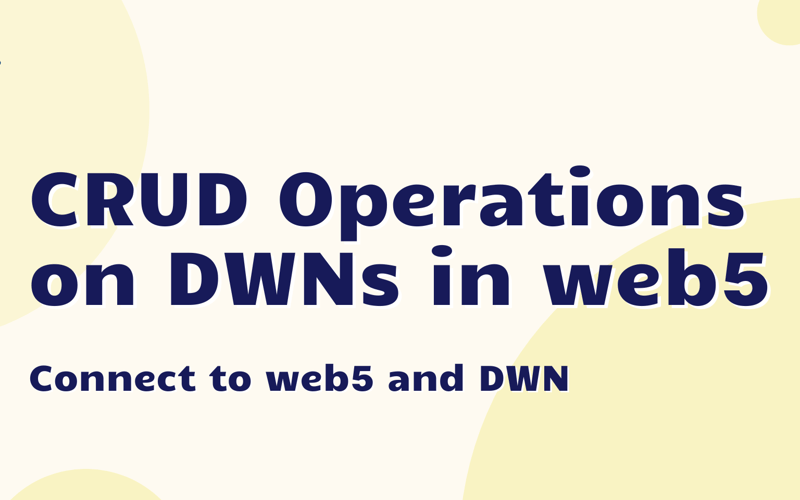The Web5 JS SDK provides an intuitive interface that allows you to swiftly develop Web5 applications. By using the Web5.connect() method to initialize the SDK, you can quickly access APIs for working with Decentralized Identifiers (DIDs) and Decentralized Web Nodes (DWNs).
In this practical guide, we will connect to the free DIF community node instance, located at https://dwn.gcda.xyz, which is hosted on Google Cloud.
Let’s get started by opening our previously created index.js file and import the Web5 class
// index.js
import { Web5 } from "@web5/api"
Connect to Web5
We’ll use the Web5.connect() method that initializes an instance of Web5, allowing your application to connect to an existing Decentralized Identifier (DID) or create a new one through an identity agent. This method also spins up a local Decentralized Web Node (DWN) linked to the DID.
The local DWN can synchronize with a specified remote DWN, ensuring connectivity and data consistency across devices. In the technical preview of the Web5 JS SDK, a remote DWN is automatically provisioned and synced with the local DWN every two minutes.
Example usage:
const { web5, did: userDid } = await Web5.connect();
Options
The connection process allows the app to either request access to a user’s local identity app (desktop or mobile) or create an in-app DID if the user lacks an identity app. The outputs from this method will be used in subsequent API calls.
Parameters
-
options:
Web5ConnectOptions(optional)- Return Value:
- web5: Instance of Web5 for accessing the local DWN and DID methods.
- did: Instance of DidApi representing the connected or created DID.
Examples
Connect without parameters:
const { web5, did: userDid } = await Web5.connect();
Connect to the DIF Community Node:
const { web5, did } = await Web5.connect({
didCreateOptions: {
dwnEndpoints: ['https://dwn.gcda.xyz'] // Community DWN instance on Google Cloud
},
registration: {
onSuccess: () => {
console.log("Connected success fully")
},
onFailure: (error) => {
console.error('Connection failed:', error);
},
},
});
Connect with an existing DWN endpoint:
const { web5, did } = await Web5.connect({
techPreview: {
dwnEndpoints: ['https://dwn.your-domain.org/'],
},
});
Connect with an existing agent and DID:
const { web5, did } = await Web5.connect({
agent: identityAgent,
connectedDid: existingDid,
});
Configure sync interval:
const { web5, did } = await Web5.connect({
sync: '5s', // Set sync interval to 5 seconds
});
Implementation in our project
For our practical guide, we’ll proceed with the connection the DIF free DWN, and at this point we just have to add the following line to our index.js file
// index.js
// ....
const { web5, did } = await Web5.connect({
didCreateOptions: {
dwnEndpoints: ['https://dwn.gcda.xyz'] // Community DWN instance on Google Cloud
},
registration: {
onSuccess: () => {
console.log("Connected success fully")
},
onFailure: (error) => {
console.error('Connection failed:', error);
},
},
});
// Display the connected DID in the console
console.log("nConnected did:", did);
now open your console and run the project by typing
node index.js
the output should look a the foolwing
SECURITY WARNING: You have not set a password, which defaults to a static, guessable value. This significantly compromises the security of your data. Please configure a secure, unique password.
iterations: 2, time lapsed: 1 ms
iterations: 2, time lapsed: 0 ms
Connected successfully
Connected did: did:dht:oqrbjwa7xsghig37wgjzfh5hrrhxp5skycscfdyobm6ooskhjfxy
at this point your index.js file should look as the follwing
Good job so far
Next ⏩️ ⏩️ ⏩️ Create records on a DWN
Prev ⏪️ ⏪️ ⏪️ Setting Up the Workspace for Decentralized Web Nodes in JavaScript
Source link
lol

